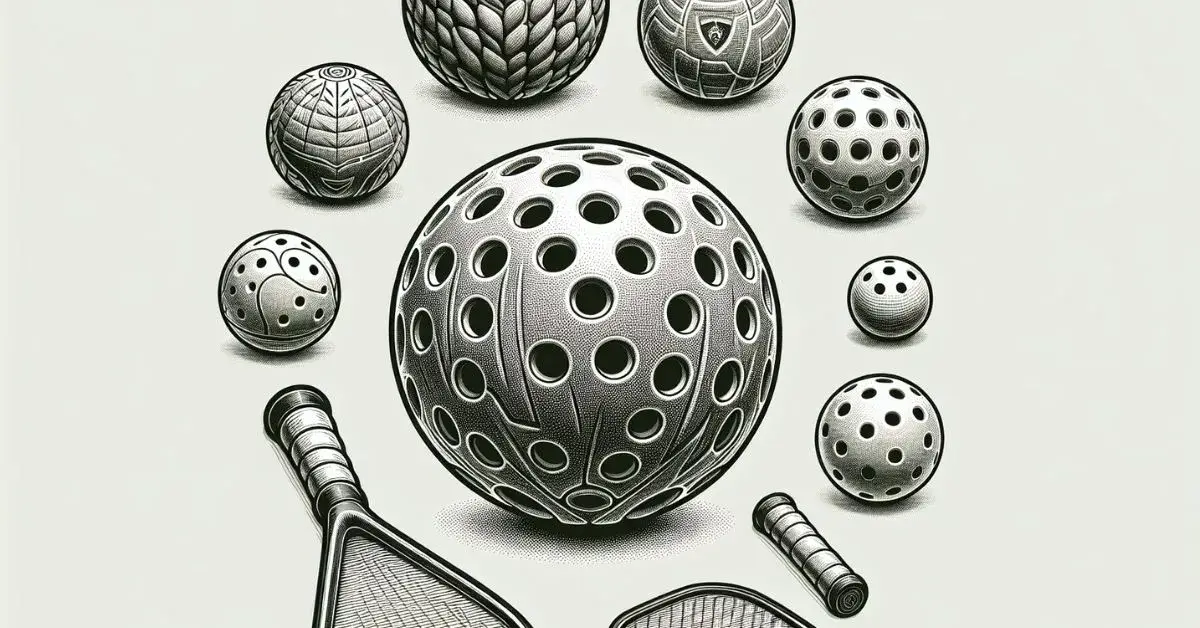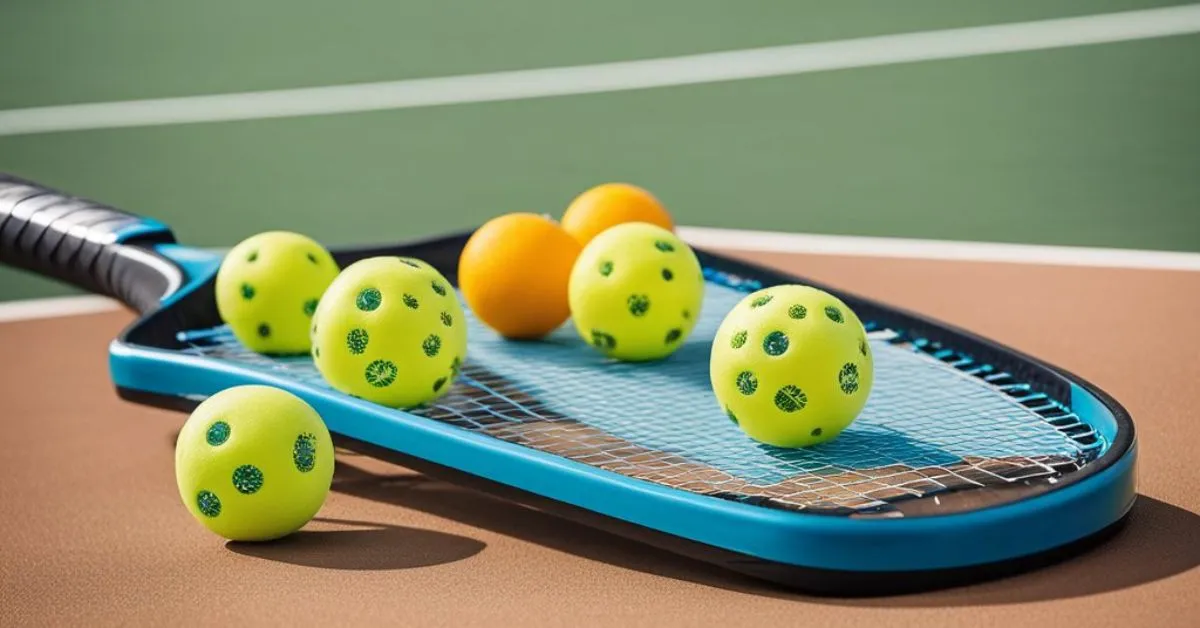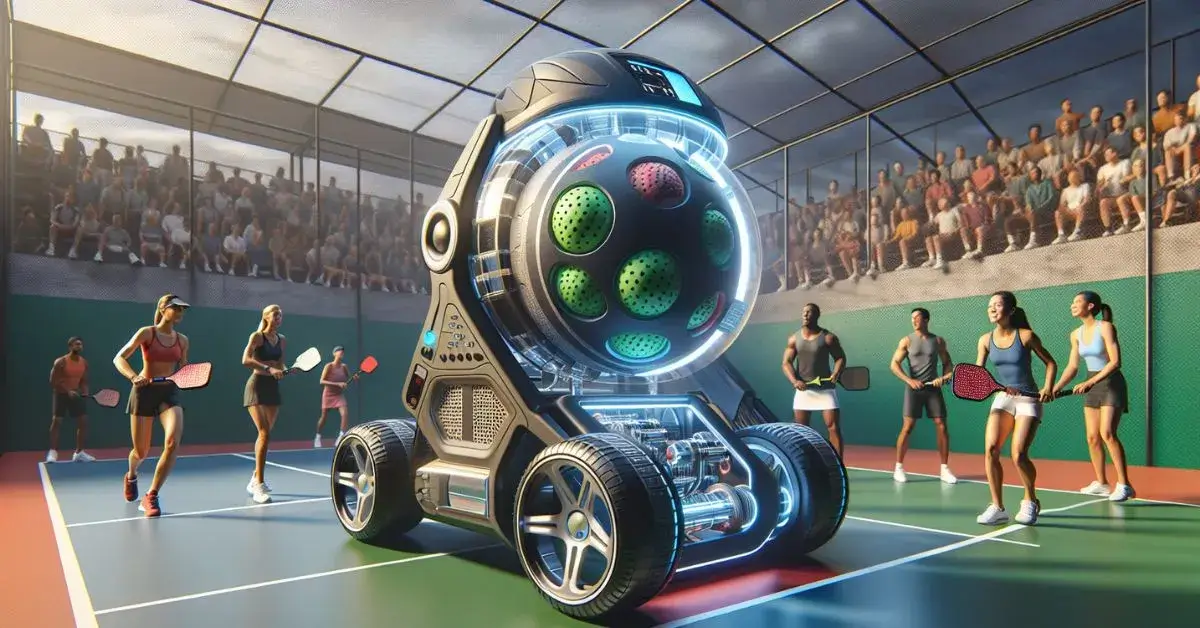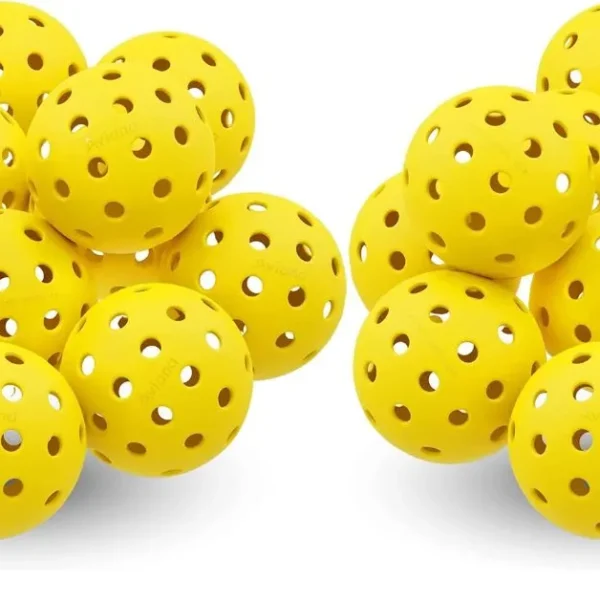This article is all about understanding the different ball sizes in pickleball. Pickleball is a fun game that is a mix of tennis, badminton, and ping pong. But did you know that pickleball balls come in different sizes? Yes, it’s true! Just like people come in different sizes, so do pickleball balls.
In this article, we will explain everything you need to know about pickleball ball size, how to choose the right one for your game, and what are the official rules for pickleball balls.
Understanding Pickleball Ball Sizes
Definition of Pickleball
Pickleball is a popular racquet sport that combines elements of tennis, badminton, and ping pong. It is played on a court with the same dimensions as a doubles badminton court, and players use solid paddles to hit a perforated ball over a net. The sport can be played both indoors and outdoors, and the ball used in pickleball comes in different sizes.
Importance of Ball Size in Pickleball
The size of the ball used in pickleball is an important factor that can greatly impact the game play. The size of the ball affects the speed, trajectory, and overall feel of the game. It is therefore crucial to understand the different ball sizes in pickleball and their implications for players.
Different Types of Pickleball Balls
Indoor Pickleball Balls
Indoor pickleball balls are designed specifically for use in indoor courts. These balls are slightly softer and have smaller holes compared to outdoor balls. They are also generally lighter in weight. The smaller holes help to slow down the ball and reduce its travel distance, making it easier for players to control their shots in the confined space of an indoor court.
Outdoor Pickleball Balls
Outdoor pickleball balls are specifically designed for use on outdoor courts. They are made with more durable materials and have larger holes compared to indoor balls. The larger holes allow for better wind resistance, making the ball more stable and predictable in outdoor playing conditions. Outdoor balls are also slightly heavier than indoor balls, which helps them withstand the impact of outdoor elements such as wind and humidity.
Other Specialized Types
In addition to indoor and outdoor balls, there are other specialized types of pickleball balls available. These include high-altitude balls for use in locations with higher elevation, noise-reduced balls for play in noise-sensitive areas, and foam balls for beginners or younger players. Each specialized ball caters to specific playing conditions or player needs.
Is There a Difference Between Indoor and Outdoor Pickleball Balls?
Yes, there is a difference between indoor and outdoor pickleball balls. Indoor and outdoor pickleball balls have different characteristics that affect their performance and durability.
Indoor pickleball balls are smaller and lighter than outdoor balls, have fewer but larger holes, have a softer texture, and are quieter and less painful when they hit someone. They are more suitable for indoor courts that have less wind and smoother surfaces.
Outdoor pickleball balls are larger and heavier than indoor balls, have more but smaller holes, have a harder texture, and are louder and harder to control. They are more suitable for outdoor courts that have more wind and rougher surfaces.
Size Specifications for Indoor Pickleball Balls
Diameter
The diameter of an indoor pickleball ball is usually around 2.875 inches (73 mm). This smaller size helps in controlling the ball’s speed and allows players to execute precise shots.
Weight
Indoor pickleball balls typically weigh between 0.8 and 0.9 ounces (22 grams). The lighter weight allows for better control and maneuverability during gameplay.
Number of Holes
Indoor pickleball balls usually have 26 to 40 holes. The smaller number of holes helps in reducing the amount of air resistance and slowing down the ball’s flight path.
Specific Brands of Indoor Balls
There are several popular brands that manufacture indoor pickleball balls, including Onix, Dura, and Franklin. These brands have been trusted by players for their quality and consistency in performance.
Size Specifications for Outdoor Pickleball Balls
Diameter
The diameter of an outdoor pickleball ball is typically around 2.9375 inches (75.5 mm). The slightly larger size compared to indoor balls aids in better visibility and tracking of the ball during outdoor play.
Weight
Outdoor pickleball balls are slightly heavier than their indoor counterparts, weighing between 0.9 and 1.0 ounces (26.5 grams). The increased weight helps the ball withstand outdoor elements and provides more stability in windy conditions.
Number of Holes
Outdoor pickleball balls usually have 26 to 40 holes, similar to indoor balls. The holes are larger in size and allow for better air resistance, enabling the ball to maintain a more predictable flight path outdoors.
Specific Brands of Outdoor Balls
Popular brands that manufacture outdoor pickleball balls include Onix, Dura, Franklin, and Engage. These brands have developed outdoor balls specifically designed to withstand the demands of outdoor play.
Some of the most best pickleball balls are:
- [Dura Fast 40]: This is the official ball of the US Open Pickleball Championships and the USAPA National Championships. It is an outdoor ball that has 40 small holes, a hard texture, and a high bounce. It is available in yellow, orange, white, or neon colors.
- [Onix Fuse G2]: This is the official ball of the Tournament of Champions and the Margaritaville USA Pickleball National Championships. It is an outdoor ball that has 40 small holes, a softer texture, and a lower bounce. It is available in yellow or orange colors.
- [Franklin X-40]: This is the official ball of the USAPA Regional Tournaments and the World Pickleball Championship. It is an outdoor ball that has 40 small holes, a hard texture, and a high bounce. It is available in yellow or optic yellow colors.
- [Jugs Bulldog]: This is one of the most popular indoor balls among the pros. It has 26 large holes, a soft texture, and a low bounce. It is available in yellow or white colors.
Impact of Ball Size on Game Play
Physics of Pickleball: How Size Affects Movement
The size of the pickleball ball directly influences its movement on the court. Smaller balls tend to travel at a slower speed and have a lower bounce, making them easier to control. On the other hand, larger balls move faster and have a higher bounce, adding an element of challenge and requiring more skill to handle.
How Different Sizes Affect Players’ Strategies
The choice of ball size also affects players’ strategies in the game. Smaller balls are easier to manipulate and control, which may favor players who prefer a slower-paced game with precise shots. Larger balls, on the other hand, require more power and skill to handle, making the game more dynamic for players who enjoy a faster-paced style of play.
Choosing the Right Ball Size for Your Game
Considerations in Choosing Ball Size
When selecting the right ball size for your game, it is essential to consider your playing style, preferences, and the playing conditions. If you enjoy a slower-paced game with more control, a smaller ball may be a better choice. On the other hand, if you prefer a faster, more challenging game, a larger ball may suit you better.
Personal vs. Tournament Play
In casual or recreational play, players have the flexibility to choose the ball size that suits their preferences. However, in tournament play, players must adhere to the regulations set by governing bodies, which specify the ball size to be used.
Gender, Age, and Skill Level Considerations
Gender, age, and skill level can also influence the choice of ball size. Younger or less experienced players may find it easier to control a smaller ball, while more advanced players may enjoy the challenge of a larger ball. It is important to choose a ball size that allows players to fully enjoy the game and showcase their skills.
Pickleball Ball Size and Regulations
USA Pickleball Association Regulations
The USA Pickleball Association (USAPA) is the governing body for pickleball in the United States. According to the USAPA regulations, all sanctioned tournaments in the country must use an indoor ball size with a diameter of 2.875 to 2.992 inches.
International Federation of Pickleball Regulations
Internationally, the International Federation of Pickleball (IFP) governs the sport and sets regulations for ball sizes. The IFP specifies an outdoor ball size with a diameter ranging from 2.874 to 2.972 inches for international tournaments.
Official Pickleball Ball Rules
The official rules for pickleball balls are set by the USA Pickleball Association (USAPA) and the International Federation of Pickleball (IFP), which are the governing bodies of the sport. The rules specify the following requirements for pickleball balls:
- Construction: The ball must be made of a durable material with a smooth surface and free of texturing. The ball must be one uniform color, except for identification markings. The ball may have a slight ridge at the seam, as long as it does not significantly impact the ball’s flight characteristics.
- Size: The ball must be between 2.87 inches (73 mm) and 2.97 inches (75.5 mm) in diameter. The maximum out-of-round diameter variance must not be greater than +/-0.020 inch (0.51 mm).
- Weight: The ball must weigh between 0.78 ounces (22 grams) and 0.935 ounces (26.5 grams).
- Bounce: The ball must have a bounce of 30 to 34 inches (76 cm to 86 cm) to the top of the ball when dropped from a height of 78 inches (198 cm) onto a granite surface plate that is at least 12 inches (30 cm) by 12 inches (30 cm) by 4 inches (10 cm). The test must be performed at an ambient temperature of 75 to 80 degrees F (24 to 27 degrees C).
- Hardness: The ball must have a hardness of 40 to 50 on a Durometer D scale at an ambient temperature of 75 to 80 degrees F (24 to 27 degrees C).
- Design: The ball must have a minimum of 26 to a maximum of 40 circular holes, with spacing of the holes and overall design of the ball conforming to flight characteristics. The ball must have manufacturers’s or supplier’s name or logo printed or embossed on it.
- Approval: The tournament director will choose the tournament ball. The ball selected for play in any USAPA- or IFP-sanctioned tournament must be named on the official list of approved balls posted on the USAPA website.
Common Myths About Pickleball Ball Size
Misconceptions About Ball Size
There are several misconceptions surrounding pickleball ball size. One common myth is that the size of the ball significantly affects a player’s performance. While ball size can impact gameplay, it is ultimately the player’s skill, strategy, and technique that determine their performance on the court.
Size and Performance: Clearing Up Confusion
It is important to understand that while ball size does play a role in the game, it is not the sole determinant of performance. Practice, experience, and skill development are key factors that contribute to a player’s success in pickleball. Ultimately, players should focus on improving their technique and game sense rather than solely relying on the size of the ball.
Maintenance and Care of Pickleball Balls
Extending the Life of Your Balls
To extend the lifespan of pickleball balls, it is important to take proper care of them. After each use, it is recommended to clean the balls with mild soap and water, ensuring the removal of dirt and debris. Storing the balls in a cool and dry place can also help maintain their quality and prevent deformation.
When to Replace Your Balls
Over time, pickleball balls may lose their bounce and performance due to wear and tear. Signs that indicate the need for ball replacement include cracks, visible damage, or a significant decrease in bounce. Regularly inspecting the balls and replacing them when necessary will ensure consistent gameplay and enjoyment.
Developments in Pickleball Ball Size and Design
Recent Developments and Innovations
The sport of pickleball is continuously evolving, and new developments in ball size and design are constantly being explored. Manufacturers are experimenting with materials, hole patterns, and ball sizes to enhance gameplay and meet the evolving needs of players.
Future Trends in Pickleball Design
As pickleball gains popularity worldwide, it is anticipated that there will be further advancements in ball size and design. The focus will likely be on improving durability, enhancing playability in different conditions, and catering to the diverse preferences of players.
In conclusion, understanding pickleball ball sizes is crucial for players to optimize their gaming experience. The size of the ball can impact gameplay, strategy, and overall performance. By familiarizing themselves with the different ball sizes and considering their own preferences and playing conditions, players can make informed choices and fully enjoy the sport of pickleball.
How long do pickleballs last?
Pickleballs can last anywhere from a few hours to a few months, depending on how often and how hard they are used. Pickleballs can wear out due to abrasion from the court surface, impact from the paddles, or exposure to environmental factors. Some signs of a worn-out ball are:
- Cracks or splits on the surface or seam
- Flattened or distorted shape
- Loss of bounce or hardness
- Faded or discolored appearance
- Change in sound or feel
To extend the lifespan of your pickleballs, you should:
- Store them in a cool and dry place away from direct sunlight
- Clean them regularly with mild soap and water
- Replace them when they show signs of wear or damage
FAQs
Is There a Difference Between Pickleball Balls vs Wiffleball Balls?
Yes, there is a difference between pickleball balls vs wiffleball balls. Wiffleball balls are larger and lighter than pickleball balls, usually around 3.5 inches (89 mm) in diameter and 0.6 ounces (17 grams) in weight. They also have fewer but irregularly shaped holes (usually 8) that make them curve unpredictably when thrown.
What is Quiet Pickleball Balls?
Quiet pickleball balls are pickleball balls that are designed to reduce noise when they hit the paddle or the court. They usually have fewer but larger holes (usually 26) that make them quieter than standard pickleball balls. They also have a softer texture that makes them less painful when they hit someone.
How fast do pickleball balls travel?
Pickleball balls can travel up to 60 miles per hour (97 km/h) when hit by a pro player with a powerful paddle. However, the average speed of pickleball balls is much lower, around 20 to 30 miles per hour (32 to 48 km/h).
What is the difference between yellow and orange pickleballs?
The difference between yellow and orange pickleballs is mainly the color. Yellow and orange are two of the most common colors for pickleball balls because they are easy to see on the court. However, some players may prefer one color over the other depending on the background or their personal taste.
Why do pickleball balls have holes?
Pickleball balls have holes to reduce air resistance and allow the ball to fly faster and farther. The holes also affect the ball’s spin, bounce, and trajectory. The number, size, and placement of the holes can vary depending on the type of ball and the manufacturer.
What are pickleball balls made of?
Pickleball balls are made of hard plastic, usually polyethylene or polypropylene. These materials are durable, lightweight, and resistant to cracking or splitting. However, they can also degrade over time due to exposure to sunlight, heat, moisture, or chemicals.





